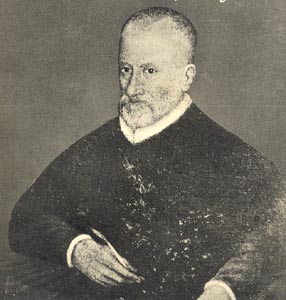Giovanni Pierluigi Da Palestrina

Questions and Answers
- 1.
According to the composer profile, all of the following are characteristics of Palestrina's music, except:
- A.
Carefully controlled use of dissonances
- B.
Flowing accompaniment parts for organ
- C.
Seamless rhythmic flow
Correct Answer
B. Flowing accompaniment parts for organExplanation
The given correct answer is "flowing accompaniment parts for organ." This means that one of the characteristics of Palestrina's music is not the presence of flowing accompaniment parts for organ.Rate this question:
-
- 2.
The picture on p. 178 shows Palestrina presenting some of his masses to:
- A.
His mother
- B.
His teacher
- C.
The pope
Correct Answer
C. The popeExplanation
The correct answer is the pope because Palestrina, a renowned composer of the Renaissance period, is shown presenting some of his masses to the pope in the picture on page 178. This suggests that Palestrina is seeking recognition and approval from the highest authority in the Catholic Church, which was a common practice for composers during that time.Rate this question:
-
- 3.
Palestrina's Missa Papae Marcelli convinced the Council of Trent not to ban Polyphonic music from the Roman Catholic liturgy.
- A.
True
- B.
False
Correct Answer
B. FalseExplanation
Palestrina's Missa Papae Marcelli did not actually convince the Council of Trent not to ban Polyphonic music from the Roman Catholic liturgy. While the piece is often cited as an example of the beauty and clarity of polyphonic music, it was not the decisive factor in the Council's decision. The Council did express concerns about the complexity and intelligibility of polyphonic music, but ultimately decided to preserve it with certain reforms and guidelines.Rate this question:
-
- 4.
Compared with Orlande de Lassus, Palestrina's compositional style is said to be:
- A.
Conservative
- B.
Progressive
- C.
Radical
Correct Answer
A. ConservativeExplanation
Palestrina's compositional style is considered conservative compared to Orlande de Lassus. This means that Palestrina adheres more closely to traditional musical techniques and structures, while Lassus may have been more experimental and innovative in his approach. Palestrina's music is characterized by its clarity, balance, and adherence to strict counterpoint rules, which were valued during the Renaissance period. In contrast, Lassus may have incorporated more adventurous harmonies and expressive techniques in his compositions, pushing the boundaries of the musical style of the time.Rate this question:
-
- 5.
How many settings of the Mass Ordinary did Palestrina compose?
- A.
88
- B.
104
- C.
162
Correct Answer
B. 104Explanation
Palestrina composed 104 settings of the Mass Ordinary. This means that he created 104 different musical compositions for the parts of the Mass that remain the same throughout the liturgical year. These settings include the Kyrie, Gloria, Credo, Sanctus, and Agnus Dei, which are essential components of the Catholic Mass. Palestrina's extensive contribution to the Mass Ordinary demonstrates his mastery of sacred choral music and his significant influence on Renaissance polyphony.Rate this question:
-
- 6.
Where did Palestrina die in 1594?
- A.
Venice
- B.
Florence
- C.
Rome
Correct Answer
C. RomeExplanation
Palestrina died in Rome in 1594.Rate this question:
-
Quiz Review Timeline +
Our quizzes are rigorously reviewed, monitored and continuously updated by our expert board to maintain accuracy, relevance, and timeliness.
-
Current Version
-
Mar 20, 2023Quiz Edited by
ProProfs Editorial Team -
Mar 02, 2011Quiz Created by
Calkeremh
 Back to top
Back to top


